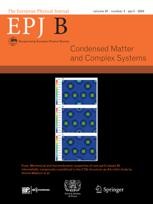Examining heat transfer in granular materials
Heat transfer through granular materials in a humid atmosphere occurs mainly through the air in the case of larger particles, and via water capillary bridges for smaller particles.
New York | Heidelberg, 22 February 2023
 Granular materials contain large numbers of small, discrete particles, which collectively behave like uniform media. Their thermal conductivity is crucial to understanding their overall behaviour – but so far, researchers haven’t considered how this value is affected by the surface roughness of their constituent particles. Through new analysis published in EPJ B, Bo Persson at the Peter Grünberg Institute, part of the Jülich Research Centre in Germany, has discovered that when this roughness is considered, thermal conductivity in granular materials is heavily influenced by particle sizes. These findings could help physicists to better describe a wide array of granular materials: from sand and snow, to piles of rice, coffee beans, and fertilizer.
Granular materials contain large numbers of small, discrete particles, which collectively behave like uniform media. Their thermal conductivity is crucial to understanding their overall behaviour – but so far, researchers haven’t considered how this value is affected by the surface roughness of their constituent particles. Through new analysis published in EPJ B, Bo Persson at the Peter Grünberg Institute, part of the Jülich Research Centre in Germany, has discovered that when this roughness is considered, thermal conductivity in granular materials is heavily influenced by particle sizes. These findings could help physicists to better describe a wide array of granular materials: from sand and snow, to piles of rice, coffee beans, and fertilizer.
The thermal conductivity of a granular material will typically be much smaller than that of solid blocks of the same material. Its value is affected by several factors: including particle shapes and sizes; the nature of their contact between each other; and the temperature, pressure, and humidity of the gas surrounding the particles. Most previous studies have only considered how heat is transferred between smooth, spherical particles – but in reality, particles have a surface roughness on many length scales, which heavily affects the thermal conductivity of the overall material.
In his study, Persson examines the thermal conductivity of granular materials in a humid atmosphere, where heat flows via air and water are especially relevant. Unlike previous studies, he considered particles with a mathematically-defined surface roughness – found in real particles produced through the crushing of brittle minerals. For particles smaller than 10 microns, he found that heat transfer in humid air is dominated by water capillaries, which form in the gaps between particles. In contrast, for bigger particles, heat is mostly transferred through the air. These discoveries clarify the mechanisms driving thermal conductivity in granular materials, and will enable researchers in future studies to simulate their physical properties more closely.
Reference: Persson, B.N.J. Heat transfer in granular media consisting of particles in humid air at low confining pressure. Eur. Phys. J. B 96:14 (2023). https://doi.org/10.1140/epjb/s10051-023-00483-5
Further Information
For more information visit: www.epj.org
Services for Journalists
The full-text article is available here.
Contact
Sabine Lehr | Springer | Physics Editorial Department
tel +49-6221-487-8336 | sabine.lehr@springer.com
